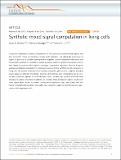Synthetic mixed-signal computation in living cells
Author(s)
Rubens, Jacob R.; Selvaggio, Gianluca; Lu, Timothy K.
Downloadncomms11658.pdf (453.5Kb)
PUBLISHER_CC
Publisher with Creative Commons License
Creative Commons Attribution
Terms of use
Metadata
Show full item recordAbstract
Living cells implement complex computations on the continuous environmental signals that they encounter. These computations involve both analogue- and digital-like processing of signals to give rise to complex developmental programs, context-dependent behaviours and homeostatic activities. In contrast to natural biological systems, synthetic biological systems have largely focused on either digital or analogue computation separately. Here we integrate analogue and digital computation to implement complex hybrid synthetic genetic programs in living cells. We present a framework for building comparator gene circuits to digitize analogue inputs based on different thresholds. We then demonstrate that comparators can be predictably composed together to build band-pass filters, ternary logic systems and multi-level analogue-to-digital converters. In addition, we interface these analogue-to-digital circuits with other digital gene circuits to enable concentration-dependent logic. We expect that this hybrid computational paradigm will enable new industrial, diagnostic and therapeutic applications with engineered cells.
Date issued
2016-06Department
Massachusetts Institute of Technology. Synthetic Biology Center; Massachusetts Institute of Technology. Department of Biological Engineering; Massachusetts Institute of Technology. Department of Electrical Engineering and Computer Science; Massachusetts Institute of Technology. Microbiology Graduate Program; Massachusetts Institute of Technology. Research Laboratory of ElectronicsJournal
Nature Communications
Publisher
Nature Publishing Group
Citation
Rubens, Jacob R., Gianluca Selvaggio, and Timothy K. Lu. “Synthetic Mixed-Signal Computation in Living Cells.” Nature Communications 7 (June 3, 2016): 11658.
Version: Final published version
ISSN
2041-1723